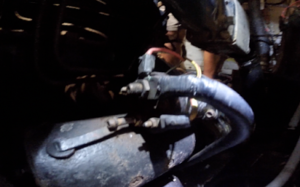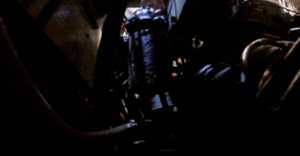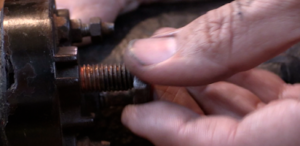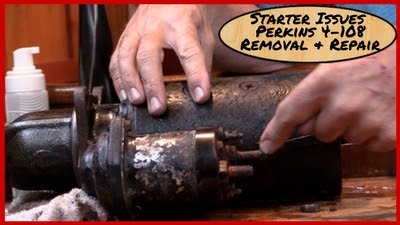In last weeks blog and youtube Video we talked about anchoring out with our friends at Brady Island.
It was great fun, but as I think I mentioned in that video, we had some trouble with our starter on that trip. So the plan was certainly to spend some time and see what was wrong with it. We planned on potentially rebuilding, replacing etc. It all had to be determined based on what I found when I removed the old one.
 Way before we get to the point of showing the starter up close in the picture above, we have to get it off the engine.
Way before we get to the point of showing the starter up close in the picture above, we have to get it off the engine.
This is not usually a hard process, but remember everything on a boat is in tight quarters and this was going to be no exception. That said, we are likely luckier than most given that we have an actual engine room as opposed to a few holes you can reach in from the galley or walk through hallway or from under the companionway steps. This photo is me sitting on the floor right in the doorway of the engine room. The camera is sitting on the other side of the engine facing the starboard side of the boat.

The next step was to remove the wires attaching the starter to the boat. It was really important to check voltage on the connections and then turn off the main battery cutoff to the 12volt system prior to doing any work. After cutting off the DC power, I went ahead and checked the voltage at the starter again. This is an older boat, and it is always good to be sure that things are truly not bypassing some of the safety equipment that is in place, such as a battery cut off. The good news it was not bypassed.
Given the size of the cables and the amperage available to it, the last thing I wanted was the positive cable going to the starter to short with something. These cables are so large, it could easily cause a VERY large dead short and potentially catch fire.

After getting the cables all loosened up and removed. I went ahead and taped around the exposed ring connectors on all of them to ensure that when I turned the 12V power back on they would not be in a position to mistakingly arc, or short with anything. I not only taped them, but I also strategically placed them in areas that would avoid them making contact with any metal that is grounded such as the engine.
After the wires were all loose, it was time to remove the 3 bolts that hold the starter and spacer to the engine itself. These were not horribly difficult to get off. They were not convenient, however, there are likely many jobs that would be much harder to reach the bolts and nuts. This was certainly manageable.

Once loose, it was just now time to take it out of the engine, lift it up out of the engine room (without dropping it below the engine into the couple inches of water and muck that is always there) and then getting it wiped off so that we can start to take a look at the starter, connections and do a little troubleshooting. I put it onto a work surface over the sink so I could take a closer look and this very loose bolt that connects the power to the starter is certainly not helping things given it is loose. There will be more to troubleshoot as I dig into it a bit more.
Check out next weeks blog and video where we dig into this and troubleshoot the starter, order the new one, realize it is the wrong one and start that process over again until we get a new one put back on the boat.
In the video below you can see the first of a 2 part series on replacing the starter, including removal, troubleshooting, testing and the mishaps that come along with just about any boat repair project.
Click here to Subscribe to our Youtube Channel

